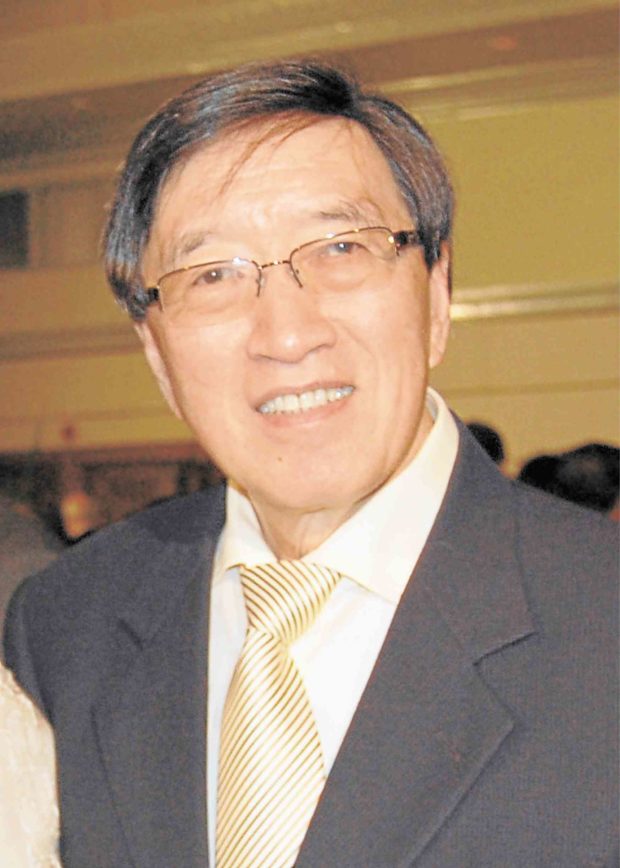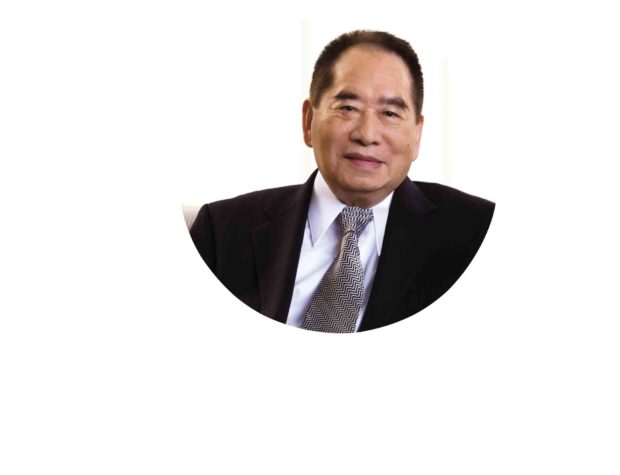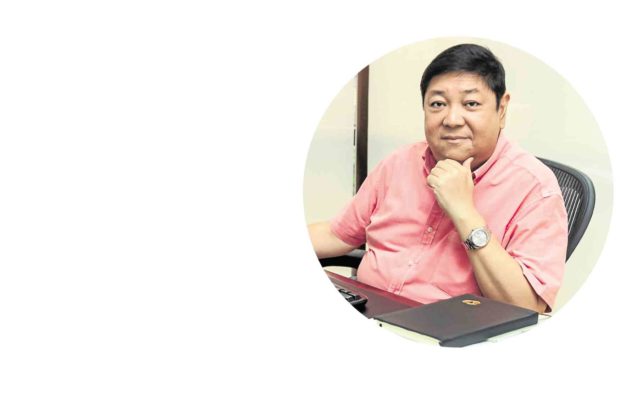Passing of an era
The country’s prominent tycoons led the biggest conglomerates through which they further grew their empire while contributing to nation-building, job creation and income generation.
They are also some of the wealthiest people in the country, whose respective companies have poured in massive investments in different industries, and spearheaded efforts to continually evolve and cater to the market’s needs in an ever-changing landscape.
In the real estate scene, these tycoons have likewise steered their companies to develop pioneering concepts in the office, residential, entertainment, leisure, hospitality and even industrial segments.
The late Henry Sy Sr., George Ty, John Gokongwei Jr. and Willie J. Uy worked their way from modest backgrounds to the top of the business chain with passion, grit and perseverance, enabling them to leave an enduring impact in their every endeavor.
 George Ty
George Ty
Business icon and philanthropist George S.K. Ty, founder of the Metrobank group, was prominently known for the fortune he built in banking and automotive manufacturing.
The business house led by the Ty family, GT Capital Holdings is now a diverse business conglomerate with successful joint ventures in Toyota Motor Corp., AXA Insurance and Orix Metro Leasing, to name a few.
Ty was motivated to set up his own bank after experiencing for himself how difficult it was for businessmen to get loans from banks. He obtained a license in 1961 and opened Metrobank in Binondo in 1962. The bank is now among the country’s largest, with total assets exceeding P2 trillion.
In 1979, Ty set up Metrobank Foundation. His philosophy was: “Whatever I spend for my personal and family needs and wants, I should be able to give the same or even more for charity since there are many who are needy.”
In 1988, he set up a local joint venture company with Japanese automotive giant Toyota that would eventually evolve into the automotive powerhouse in the Philippines.
Aside from these business ventures, Ty also had stakes in one of the pioneers in the Philippine real estate scene—Federal Land Inc.
As one of the country’s movers in the real estate industry and as a builder of Filipino homes, Federal Land is behind many large-scale developments: residential condominiums, office buildings, retail and commercial centers, mixed-use townships and masterplanned communities.
The property developer’s mission is to “create dynamic communities for generations to enjoy,” and under the leadership of Ty, Federal Land has made bold investment moves on massive projects targeted to offer properties with the best value for money.
Federal Land began in Manila as Federal Homes in 1972. Since then, Federal Land has built several prime properties that not only add prestige to the evolving skyline of the country but also provide investment opportunities to their partners.
Federal Land made its mark in cities across Metro Manila and the country with several prized properties, including the 47-storey GT Tower International in the Makati Central Business District, the Grand Central Park township, the 66-storey Metrobank Center, the premier Grand Hyatt Hotel and Grand Hyatt Manila Residences in Bonifacio Global City; the luxury address of Marco Polo Residences and the Marco Polo Plaza Hotel in Cebu City; the resort-inspired Six Senses Residences and Bay Garden Club and Residences, as well as the Blue Bay Walk family-and-lifestyle commercial strip in Pasay City.
Aside from luxury and premier residences, Federal Homes also built low-cost, world-class homes for families and communities through their subsidiary, Horizon Land. Properties they developed include the Four Seasons Riviera in Binondo and the Peninsula Garden Midtown Homes in Paco, the Quantum Residences near Manila’s university belt, The Capital Towers in Quezon City, and the Marquinton Residences, Tropical Garden City and Siena Towers in Marikina City.
The empire Ty has built is evident not only in the structures that are physically visible but more so in the impact his business ventures had in changing the lives of Filipinos, providing support through the banks and bancassurance, giving Filipinos tools through automobiles and power generation, and providing homes and spaces through real estate.
 Henry Sy Sr.
Henry Sy Sr.
As the founder of a shoe store in downtown Manila in 1958, the late Henry Sy Sr. “got it all” to build a chain of stores and turn it into a multibillion-dollar business empire.
The success of the over 200 companies under the SM company made him No. 1 in the Forbes Philippines rich list for 11 years in a row before his demise in January this year at the age of 94.
His net worth at the time of his death was estimated at $19 billion, making him the 53rd wealthiest person in the world, according to Forbes.
His contemporaries sang praises for him for his vision and drive, calling him “one of the great pillars of Philippine business.”
In the words of Jose Cuisia Jr., the country’s former ambassador to the United States and ex-governor of Bangko Sentral ng Pilipinas, Sy was “a generous visionary who wanted to provide Filipinos a better life” through education, and by creating jobs and providing opportunities for growth and advancement.
But Sy had to work his way to the top. He was 12 when he left an impoverished little village in Jinjiang, a county of Quanzhou City in China’s Fujian province, and flew to the Philippines to seek a better life.
“Life was hard in China and I imagined that life in the Philippines was better because my father was able to steadily send us money,” Sy was quoted saying in an interview with Sunday Inquirer Magazine a decade ago.
Sy first started selling goods in his father’s “sari-sari” (convenience) store before opening in 1958 his first two stores, dubbed Shoemart, on Rizal Avenue and Carriedo. He opened another store in 1963 in Makati and in Cubao in 1967.
He just kept going from there. He then launched his first SM Department Store in 1972 in Manila and rebranded his Makati store into a department store. In the 1980s, more SM Department Store branches were opened, until Sy’s first mall—SM North Edsa—was inaugurated in 1985.
He then grew it into a retail empire with its 72 SM Supermalls in the Philippines and seven in China generating P15 billion in revenues in the first three months of 2019.
SM Prime Holdings Inc. (SMPHI), which owns SM Supermalls, estimates an average daily foot traffic of 4.2 million in the country and 300,000 in China.
As more of Sy’s malls popped up across the country, they helped define the growing mall culture in the Philippines. Some of them have ice skating rinks, a feature that made SM Supermalls stand out.
From being just a retail visionary, Sy ventured into property development, giving hundreds of thousands of Filipinos a chance to own a comfortable and affordable home.
Through its units and subsidiaries, SMPHI also builds leisure homes, offices, hotels and convention centers. As of March this year, SM Prime counts 11 office buildings, six hotels, and seven convention centers and trade halls in its portfolio.
SM Prime’s wholly-owned unit SM Development Corp. (SMDC) is one of the leading property developers for affordable condominium units. It unveiled its first condominium project, the Chateau Elysee, in Parañaque City in 2003.
As of March this year, some 126,780 residential units have been built by SMDC since 2003. Most of its developments are located in central business districts, the Mall of Asia complex, and on the outskirts of Metro Manila, such as the provinces of Cavite, Bulacan, and Pampanga.
SMDC’s condominium developments offer top-notch amenities, such as Olympic-size swimming pools, jogging paths and libraries, among others, to promote a healthy lifestyle to their residents.
Sy was a generous philanthropist as he was a donor to charitable causes, allotting millions of pesos each year to finance the college scholarships of thousands of underprivileged Filipino youth, among others.
Through SM Foundation, Sy also donates huge amounts to healthcare, disaster response and farmers’ training.
He stepped down as chair of SMPHI in 2017, assuming the title of “chair emeritus” and making sure that his trusted allies as well as his children “got it all” for the Filipino consumers.
 John Gokongwei Jr.
John Gokongwei Jr.
John Gokongwei Jr. has left his mark in the business and investment industry. A game-changer who spearheaded different enterprises, his impact in the real estate industry stands out for touching the lives of Filipinos across all walks of life.
Among his business ventures was Robinsons Land Corp. (RLC), one of the active players in the property sector which has continuously evolved in response to the needs of society.
To Filipinos, commercial malls are not just a place for shopping. They are also places for leisure, where families bond and friends catch up. RLC’s Robinsons Malls stays true to this Filipino mall culture.
Through the Robinsons chain of malls, Gokongwei provided to Filipinos a space for dining, recreation and shopping without compromising the accessibility, comfort and security of every establishment.
RLC does not just take care of the people but also the environment.
As one of the leading mall chains and biggest consumers of energy in the country, Robinsons Malls does its part to protect the environment by using clean energy to reduce carbon footprint. In 2017, RLC started installing solar farms on the roof-decks of its shopping malls, thereby using less electricity produced by the burning of fossil fuels.
Through Gokongwei’s vision, RLC became a front-runner in providing office space to call centers, business process outsourcing companies, and local and multinational corporations in the country, with sites in over 13 key cities and municipalities nationwide.
Among RLC’s properties include the cyberparks, which cater to the Philippines’ growing information technology and business process management sector. RLC continues to address the demand for high-quality office spaces not just in the metro but also in provinces by expanding its office portfolio and providing vibrant and lasting spaces to its clients.
RLC did not just revolutionize the workplace, but also the homes of Filipinos, shaping modern lifestyle through its residential division. It caters to the residential, leisure and retirement needs of the market and has built successful mixed-use properties in Metro Manila.
Whether someone is looking for a place in the fast-paced city or a relaxed home away from the bustling metropolis, Robinsons has a perfect setting for them, still with the convenient location it never fails to provide.
RLC, through Gokongwei’s efforts, does not just offer a place for every lifestyle, but also for every financial capacity with its affordable condominiums and homes. It has three condominium brands—the Robinsons Residences, Robinsons Communities and Robinsons Luxuria—and one housing brand—Robinsons Homes.
As a leading hotel group in the country, Robinsons Hotels and Resorts, through the years, has provided utmost comfort and quality to the Filipino people in need of accommodation.
RLC offers a diverse selection of hotels and resorts. Ranging from affordable value properties (Go Hotels) to five-star international hotels (Crowne Plaza Manila Galleria, The Westin Manila Sonata Place and Dusit Thani Mactan Cebu) and midmarket hotels (Holiday Inn Manila Galleria and Summit Hotels and Resorts), there is an accommodation for everyone.
Gokongwei left a legacy not just through the establishments he built, but also through the integrity, dynamism and courage that he imprinted on RLC, in the service of the Filipino.
 Willie J. Uy
Willie J. Uy
In his more than three decades in the real estate industry, the late Willibaldo “Willie” J. Uy, 59, had a vision to provide every hardworking Filipino an affordable and decent home.
With that vision, he believed that informal settlers could be an ally of property developers, not just some nuisance.
Uy had been the 8990 Holdings Inc. president and chief executive officer from January 2018 until his passing. He left behind a sustainable housing finance program which the company pledged to implement.
Before taking the helm at 8990 Holdings, he had already collected more than 30 years of quality experience as president and CEO of real estate developer Phinma Properties, subsidiary of Phinma Corp.
Uy once said that the way to respond to the problem of informal settlements was not to simply relocate them to far-flung areas, away from their source of living and economic opportunities normally concentrated in the city; but to integrate them into the urban landscape and tap them as potential market.
“Our vision is to create an opportunity for all Filipinos to own quality yet affordable homes in strategic locations in Metro Manila. We’re not just after providing them with spacious and comfortable units, but also communities that make them feel valued,” Uy had said.
That is how Phinma Properties shifted its focus from developing upscale townhouse projects such as the Manila Polo Club houses and Mariposa Villas when it started building homes in 1987 to creating affordable mid-rise properties in the early 1990s. It then ventured into socialized housing projects.
Phinma, under Uy, created communities located in Parañaque City (Fountain Breeze) as well as in Quezon City where most of its projects are (Sunny Villas, San Benissa Garden Villas, Spazio Bernardo, Spazio Bernardo West Villas, Smile Citihomes and Smile Citihomes Annex).
Through the affordable financing schemes Phinma is known for, all projects were said to be sold out in less than a year and completed in a short period of time. This was in line with Phinma’s “City Living Made Easy” campaign, which Uy had said offered buyers “more space for the same price.”
In 2014, Phinma Properties and the Quezon City government completed the development of Sitio Looban into what is now known as Bistekville II, an in-city socialized housing in Novaliches for some 700 disadvantaged families.
Instead of getting relocated, slum dwellers were convinced to vacate their old spaces to build a mix of concrete lofted rowhouses as well as three-storey condominium buildings that would become their homes via a monthly amortization to Pag-Ibig. A total of 1,078 housing units composed of 703 lofted rowhouses (with 27-sqm total floor area) and 375 condo units (with 23-sqm floor area) were constructed.
The company also introduced green living in socialized housing with the development of solar-powered units in Grand Strikeville 4 in Bacoor, Cavite.
Uy brought with him these achievements when he became the chief operating officer at 8990 Holdings in 2012, after his retirement from Phinma Properties. Six years later, he became the president and CEO of the company, one of the top affordable-housing developers in the country.
“The passing of Willie J. Uy cast a shadow of unhappiness on the company that he loved so much. However, this has strengthened our resolve to continue the great work he did for the company,” acting 8990 Holdings president and CEO Alexander Ace Sotto said in a disclosure to the Philippine Stock Exchange on Nov. 7.
Sources: Inquirer Archives, gtcapital.com.ph, federalland.ph, sminvestments.com, smdc.com, smprime.com, forbes.com, phinmaproperties,com, 8990holdings.com, pse.com.ph




